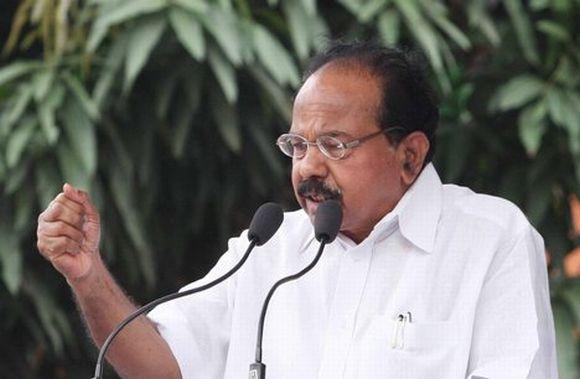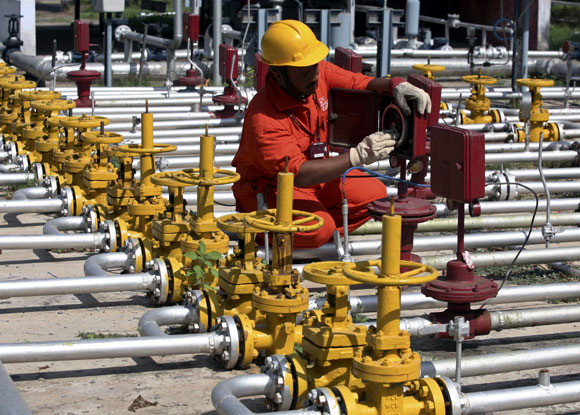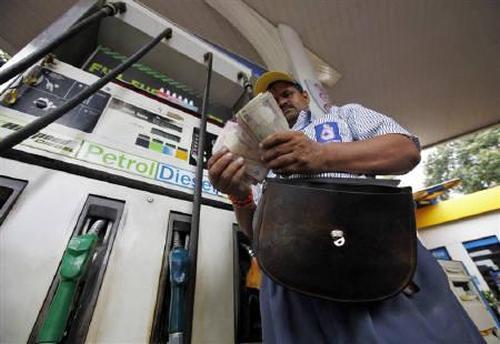Photographs: Courtesy, Veerappa Moily's website Jyoti Mukul & Shine Jacob in New Delhi
A week after the government decided to raise the price of domestic natural gas, it is still unclear what prompted Petroleum Minister M Veerappa Moily to say the new price applicable from April 2014 will be around $8.4 a million British thermal unit.
Officials said this price was nowhere in the proposal to the Cabinet, which had approved a pricing formula, not a price. The eventual price could be anywhere between $7.5 and $8 and would be changed each quarter.
Petroleum ministry officials say $8.4 an mBtu is a pricing “myth”. “Nowhere in the government notes is a price of $8.4 mentioned.”
The only logic behind the quoted figure, which would double the existing price, is that the netback price (an arrangement in which the price of gas at the well-head is based on that of the processed gas or products and then calculated backwards) of Indian LNG (liquefied natural gas) imports would be in the range of $8 an mBtu next year.
...
Gas price: Where did Moily get the $8.4 figure?
Image: Reliance Industries' KG-D6 facility located in Andhra Pradesh.Photographs: Reuters
“Taking the Henry Hub, National Balancing Point (NBP) and netback price at the source of supply into account, domestic natural gas prices are likely to be in the range of $7.5-8 an mBtu,” said a senior official.
Besides, the Cabinet Committee on Economic Affairs did not put any cap or floor to the formula, which would have no linkage to the rupee value.
Background
In 2006, when the government adopted a formula proposed by Reliance Industries Ltd (RIL) and froze the price at $4.2 an mBtu till March 2014, the fixed element in it was $2.5 denominated in rupees at an exchange rate of Rs 45 a dollar.
RIL had proposed a linkage to an average crude oil price for the previous financial year, with a cap of $65 a barrel and a floor of $25.
This was to insulate gas consumers from higher prices and the producer from an unviable price. This crude oil price was the floating element to be converted from dollar to rupees at the average of the previous year’s exchange rate. However, the government decided the price should be in dollars, and not rupees, and capped the linkage to crude oil at $60 instead of $65.
...
Gas price: Where did Moily get the $8.4 figure?
Image: Petroleum Minister Veerappa Moily.Photographs: Courtesy, PIB
Last Friday, Moily had indicated the prices were likely to be in the range of $8.4 an mBtu if the US’ Henry Hub average, NBP, Japan and LNG import pricing expected in April 2014 were taken into account.
“Spot prices were excluded because it can vary heavily, when we sit for review of pricing on a quarterly basis. This may lead to huge price fluctuations in domestic prices,” added another official.
According to an internal note of the ministry, on the basis of the approved formula, the price for natural gas in India for the April-June 2013 quarter comes to $6.83.
During the course of circulation of the Cabinet note, the Planning Commission had suggested $11.18, the finance ministry $6.99-8.93 and the Department of Fertiliser $6.68. The power ministry wanted to stick to the present cost-plus regime, which comes to $4.14.
...
Gas price: Where did Moily get the $8.4 figure?
Image: A view of Bharat Petroleum Corporation Ltd. Refinery in Mumbai.Photographs: Reuters
There are two factors that would push up the price in future. One, India would start importing more expensive Australian LNG and the other is the lifting of the price cap on Qatar LNG.
Higher cost
In an internal note assessing the impact of an increase, the petroleum & natural gas ministry estimated the subsidy burden to meet core sector demand through imported LNG could go to as high as Rs 1,20,000 crore (Rs 1.2 trillion), if the demand was not substantially met by domestic gas.
Justifying the government decision to increase the price, the note affirmed the current price of $4.2 was not viable for “sustenance of the domestic production of gas and all the operators are demanding an increase in price”.
...
Gas price: Where did Moily get the $8.4 figure?
Image: A worker at the ONGC gas plant.Photographs: Reuters.
Gujarat State Petroleum Corporation has been demanding $13-14 for their blocks in the KG-D6 basin. RIL wanted a price in the same range.
Even central public-sector undertakings - Oil and Natural Gas Corporation and Oil India Ltd - have been repeatedly representing for an increase, saying production would not be viable at a price less than $7.
Domestic production has been well short of demand. The present deficit of 142.78 million standard cubic metres a day (mscmd) is expected to increase to 234.26 mscmd in 2016-17.
“Therefore, there will be huge dependence on the import of gas at a much higher price of around $14 and above, which will simply become unaffordable for the consuming sector,” said the note.
...
Gas price: Where did Moily get the $8.4 figure?
Image: An employee counts Indian currency at a fuel station in Mumbai.Photographs: Danish Siddiqui/Reuters
A main reason for weak domestic output is viability vis-à-vis the price at which producers are supposed to sell. Around three trillion cubic feet of gas reserve is still waiting to be exploited.
According to the ministry, the investment in exploration and development plans have consistently been going down from $6 billion in 2007-08 to $1.8 billion in 2011-12. At the same time, Indian companies have invested $27 billion in the E&P sector abroad, with another $10 billion in the pipeline.
Every dollar per mBtu rise in the gas price would result in an additional burden of approximately $1 billion. However, half of it, around $500 million, will come back to the government in the form of royalty, profit, petroleum taxes and dividend.
This additional income can take care of the additional subsidy burden on fertiliser and cooking gas, if the government decides to absorb the burden.








article